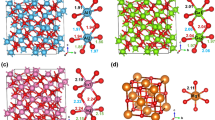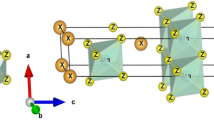Abstract
We report ab initio calculations of the atomic and electronic structures, and related magnetic properties of platinum clusters of seven atoms both pure and substitutionally doped with an iron impurity. A relativistic Hamiltonian including spin–orbit coupling effects is self-consistently solved in the noncollinear framework within the density functional theory as implemented in the VASP code. We show that spin–orbit coupling is crucial for determining the energetic order of structural isomers of small platinum clusters, but not for the low-lying iron-doped platinum clusters. We analyze the influence of Fe doping on the overall improvement of the magnetic efficiency of the nanoparticle, i.e., large total moment and high stability against remagnetization. Results are reported for the spin–orbit energy, the magnetic anisotropy energy corresponding to the remagnetization barrier, and the orbital contribution to the total magnetic moment, which can be experimentally measured in free-standing clusters by means of X-ray magnetic circular dichroism spectroscopy.




Similar content being viewed by others
References
Aguilera-Granja F, Longo RC, Gallego LJ, Vega A (2010) Structural and magnetic properties of x12y (x, y=Fe, Co, Ni, Ru, Rh, Pd, and Pt) nanoalloys. J Chem Phys 132:184507
Apsel SE, Emmert J, Deng J, Bloomfield L (1996) Surface-enhanced magnetism in nickel clusters. Phys Rev Lett 76:1441–1444
Bader RFW (1990) Atoms in molecules. A quantum theory. Clarendon, Oxford
Billas IML, Châtelain A, de Heer WA (1994) Magnetism from the atom to the bulk in iron, cobalt, and nickel clusters. Science 265:1682–1684
Błoński P, Hafner J (2009) Magnetic anisotropy of transition-metal dimers: density functional calculations. Phys Rev B 79:224418
Błoński P, Hafner J (2011) Magneto-structural properties and magnetic anisotropy of small transition-metal clusters: a first-principles study. J Phys: Condens Matter 23:136001
Błoński P, Dennler S, Hafner J (2011) Strong spin–orbit effects in small Pt clusters: geometric structure, magnetic isomers and anisotropy. J Chem Phys 134:034107
Bucher JP, Douglass DC, Bloomfield LA (1991) Magnetic properties of free cobalt clusters. Phys Rev Lett 66:3052–3055
Castro M, Jamorski C, Salahub DR (1997) Structure, bonding, and magnetism of small Fe n , Co n , and Ni n clusters, n 5. Chem Phys Lett 271:133–142
Diéguez O, Alemany MMG, C CR, Ordejón P, Gallego LJ (2001) Density-functional calculations of the structures, binding energies, and magnetic moments of fe clusters with 2 to 17 atoms. Phys Rev B 63:205407
Fernández-Seivane L, Ferrer J (2007) Magnetic anisotropies of late transition metal atomic clusters. Phys Rev Lett 99:183401
Fritsch D, Koepernik K, Richter M, Eschrig H (2008) Transition metal dimers as potential molecular magnets: a challenge to computational chemistry. J Comput Chem 29:2210–2219
García-Fuente A, Vega A, Aguilera-Granja F, Gallego LJ (2009) Mo4x fe x nanoalloy: structural transition and electronic structure of interest in spintronics. Phys Rev B 79:184403
Hobbs D, Kresse G, Hafner J (2000) Fully unconstrained noncollinear magnetism within the projector augmented-wave method. Phys Rev B 62:11556–11570
Huda MN, Niranjan MK, Sahu BR, Kleinman L (2006) Effect of spin–orbit coupling on small platinum nanoclusters. Phys Rev A 73:053201
Knickelbein MB (2001) Experimental observation of superparamagnetism in manganese clusters. Phys Rev Lett 86:5255–5257
Kresse G, Furthmuller J (1996) Efficient iterative schemes for ab initio total-energy calculations using a plane-wave basis set. Phys Rev B 54:11169–11186
Kresse G, Hafner J (1993) Ab initio molecular dynamics for liquid metals. Phys Rev B 47:558–561
Kresse G, Lebacq O (2013) VASP Manual. http://cms.mpi.univie.ac.at/vasp/vasp/vasp.html
Kumar V, Kawazoe Y (2008) Evolution of atomic and electronic structure of pt clusters: Planar, layered, pyramidal, cage, cubic, and octahedral growth. Phys Rev B 77:205418
Marsman M, Hafner J (2002) Broken symmetries in the crystalline and magnetic structures of iron. Phys Rev B 66:224409
Meshcheryakov VF, Fetisov YK, Stashkevich AA (2008) Magnetic and microwave properties of nanocomposite films on the basis of FeCoNi particles of various shapes. J Appl Phys 104:063910
Montejano-Carrizales JM, Aguilera-Granja F, Morán-López JL (2011) Structural and magnetic properties of femyn (m + n=7, y = Ru, Rh, Pd, and Pt) nanoalloys. Eur Phys J D 64:53–62
Niemeyer M, Hirsch K, Zamudio-Bayer V, Langenberg A, Vogel M, Kossick M, Ebrecht C, Egashira K, Terasaki A, Moller T, v Issendorff B, Lau JT (2012) Spin coupling and orbital angular momentum quenching in free iron clusters. Phys Rev Lett 108:057201
Perdew JP, Burke K, Ernzerhof M (1996) Generalized gradient approximation made simple. Phys Rev Lett 77:3865–3868
Peredkov S, Neeb M, Eberhardt W, Meyer J, Tombers M, Kampschulte H, Niedner-Schatteburg G (2011) Spin and orbital magnetic moments of free nanoparticles. Phys Rev Lett 107:233401
Polak M, Rubinovich L (2004) Computational study of ternary alloy nanocluster compositional structures: NiCuRh versus NiCuPd. Int J Nanosci 3:625–630
Sahoo S, Hucht A, Gruner ME, Rollmann G, Entel P, Postnikov A, Ferrer J, Fernández-Seivane L, Richter M, Fritsch D, Sil S (2010) Magnetic properties of small Pt-capped Fe, Co, and Ni clusters: a density functional theory study. Phys Rev B 82:054418
Soler JM, Artacho E, Gale JD, García A, Junquera J, Ordejón P, Sánchez-Portal D (2002) The siesta method for ab initio order-n materials simulation. J Phys Condens Matter 14:2745
Sun S, Murray CB, Weller D, Folks I, Moser A (2000) Monodisperse FePt nanoparticles and ferromagnetic FePt nanocrystal superlattices. Science 287:1989–1992
Toneguzzo P, Viau G, Acher O, Vincent FF, Fiévet F (1998) Monodisperse ferromagnetic particles for microwave applications. Adv Mater 10:1032–1035
Vega A, Dorantes-Dávila J, Balbás LC, Pastor GM (1993) Calculated sp-electron and spd-hybridization effects on the magnetic properties of small Fe n clusters. Phys Rev B 47:4742–4746
Zhen L, Gong YX, Jiang JT, Shao WZ (2008) Electromagnetic properties of FeNi alloy nanoparticles prepared by hydrogen-thermal reduction method. J Appl Phys 104:034312
Zitoun D, Respaud M, Fromen MC, Casanove MJ, Lecante P, Amiens C, Chaudret B (2002) Magnetic enhancement in nanoscale CoRh particles. Phys Rev Lett 89:037203
Acknowledgments
We acknowledge the support of the Spanish Ministry of Science and Innovation, the European Regional Development Fund, and Junta de Castilla y Leon (Grant Nos. FIS2011-22957 and VA104A11-2). P.G.A.L. acknowledges the financial support from CONACyT Ref. 165078, call 2011–2012 for sabbatical and postdoctoral positions for consolidation of research groups. F.A.G acknowledges the support from PROMEP-SEP-CA230, the Ministry of Education, Culture and Sport, Ref SAB2011-0024, Spain, and to the DIPC funds for a fellowship grant.
Author information
Authors and Affiliations
Corresponding author
Rights and permissions
About this article
Cite this article
Alvarado-Leyva, P.G., Aguilera-Granja, F., García-Fuente, A. et al. Spin–orbit effects on the structural, homotop, and magnetic configurations of small pure and Fe-doped Pt clusters. J Nanopart Res 16, 2222 (2014). https://doi.org/10.1007/s11051-013-2222-0
Received:
Accepted:
Published:
DOI: https://doi.org/10.1007/s11051-013-2222-0




